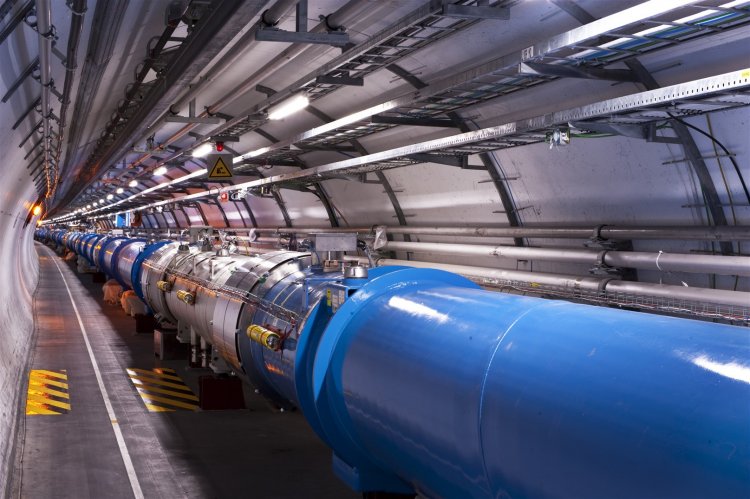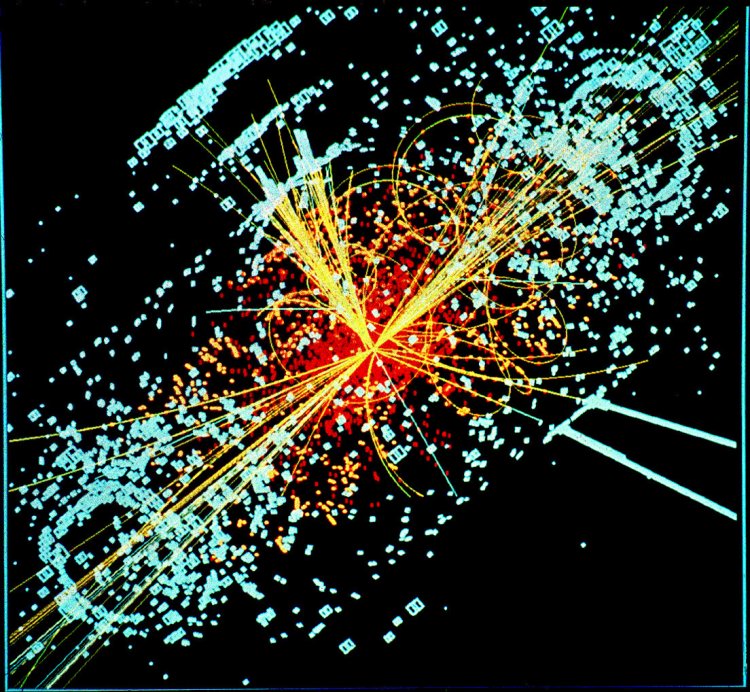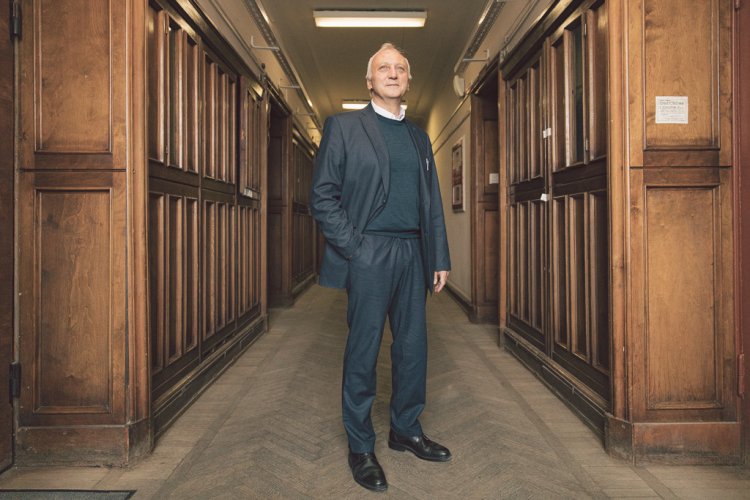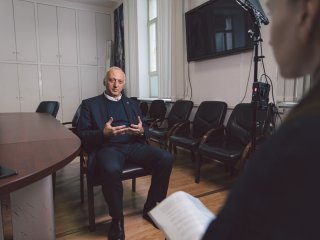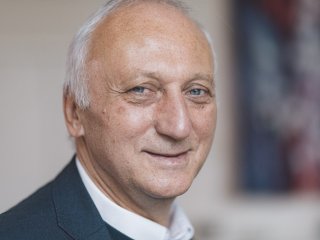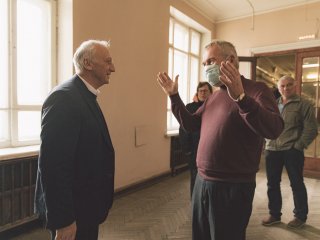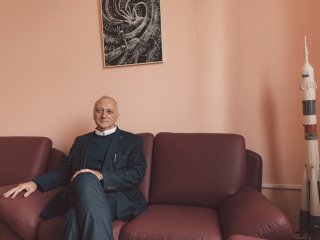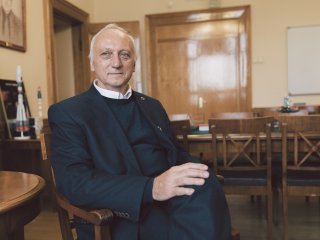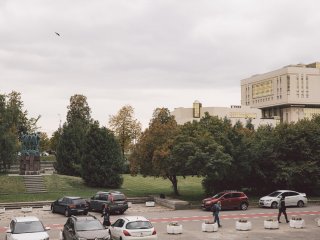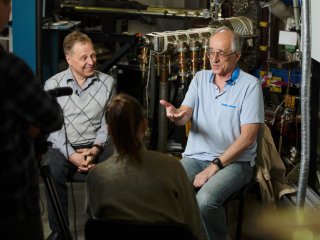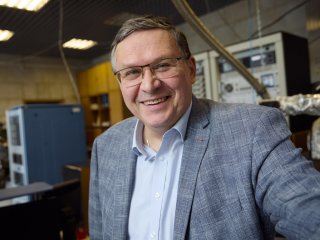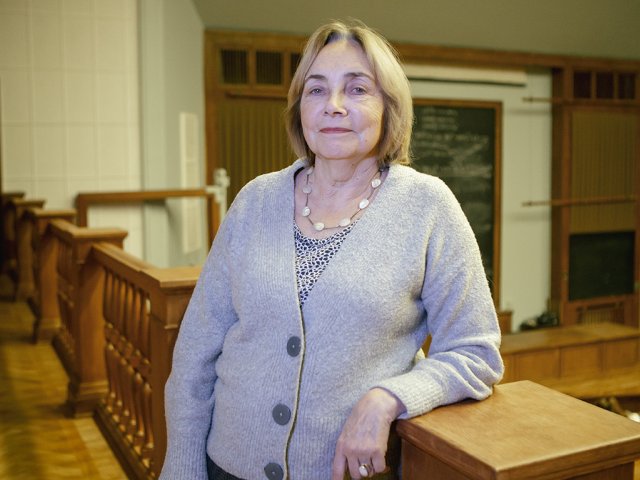Despite its impressive predictive power, the Standard Model cannot provide answers to all physical questions. But physicists are not discouraged. The Standard Model is likely just part of a deeper theory of the structure of the universe. To find out, scientists analyze particle collision reactions in accelerators and colliders, including the Large Hadron Collider. The LHC is currently undergoing modernization. Its luminosity will be increased. What does this mean for experimental physics? And what awaits us there – beyond the Standard Model? We asked Eduard Ernstovich Boos – Director of the Skobeltsyn Institute of Nuclear Physics of Moscow State University (SINP MSU).
Eduard Ernstovich Boos is Doctor of Physical and Mathematical Sciences, Professor, Corresponding Member of the Russian Academy of Sciences, Director of the Skobeltsyn Institute of Nuclear Physics of Moscow State University.
− Let’s talk about experimental physics and accelerator technology. What allows you to make discoveries?
− To begin with, for many years humanity has been dreaming of penetrating deep into the matter. For what? To penetrate the depths of the universe. As it turned out, the physics of the microcosm, that is, how our world works at the smallest distances, is closely connected with the questions of how our universe arose and according to what laws it developed.
Paradoxical, isn’t it? To understand the vast, boundless cosmic world surrounding us, we need to understand how interactions that control processes at ultra-small distances are arranged at a fundamental level.
For example, a microscope allows you to see structures that we cannot see by the naked eye. Many things are simply hidden from us because of the limitations of our vision. It seems to us that the surface of the table is quite smooth. But if we look at it through a microscope, we will notice that it is rough and very uneven.
To look at extremely small distances, other “microscopes” are used. They are commonly called accelerators or colliders. In accelerators, a beam of particles accelerated to high energy interacts with particles of a stationary target. Whereas colliders are accelerators with colliding beams, in which accelerated beams of charged particles collide. During a collision, reactions occur, the products of these reactions are born, which are recorded in large devices called detectors.
Over the years of the development of high-energy physics, a number of different accelerators and colliders have been created. At one time in the USSR, the U-70 proton accelerator was built in Protvino at the Institute for High Energy Physics − at that time the most powerful accelerator in the world. Scientists from various scientific institutes and universities of Russia and international research centers took an active part in the research on the U-70 accelerator. The scientists of the SINP MSU also participated in these studies. This laid the foundation for the further participation of the SINP and the Faculty of Physics of Moscow State University in the largest international collaborations at the colliders HERA (Hamburg, Germany), Tevatron (Batavia, USA), and LHC (Geneva, CERN).
Currently, the Large Hadron Collider (LHC) is particularly popular — the most powerful collider in history. However, other installations are also actively working, in which not only elementary particles, but also heavy ions collide. An extremely interesting project of the future NICA collider is being implemented today in Dubna at the Joint Institute for Nuclear Research. The NICA project is the largest international project in which our institute is actively involved. In the NICA project, mainly heavy nuclei, including gold nuclei, will collide. By studying such collisions, physicists hope to analyze how the universe was arranged in the first stages of its development.
Let’s go back to the Large Hadron Collider. Currently, the installation is not working, because the so-called modernization is underway, that is, the improvement of the accelerator itself, accelerating systems and detectors. The scientific community hopes that in 2022, perhaps with a slight delay, the LHC will resume operation and bring new results.
LHC fragment, sector 3-4
But the accelerator fleet is not limited to large machines with high energies. More compact accelerators with lower energies are much more widely used both in science and in applied areas. For example, our institute has a group of researchers developing electron accelerators under the leadership of Professor Vasily Ivanovich Shvedunov − one of the world leaders in this field. A team of scientists studies the reactions of the interaction of electrons and photons formed when they enter the substance with various atomic nuclei at significantly lower energies compared to the LHC. The conducted research makes it possible to find out various aspects of the structure of atomic nuclei, to study the features of excited states, to analyze transitions from one nuclear level to another. In addition to purely scientific applications, such installations have several practical applications. In particular, in the field of security. With the help of small accelerators, specialists irradiate a wide variety of objects for the detection of prohibited substances.
But if we talk about the fundamental structure of matter at the smallest distances, about the interaction of particles at distances 3-4 orders of magnitude smaller than the size of a proton or neutron, then the main information comes today from the Large Hadron Collider.
− When they talk about its modernization, they mention that the luminosity will be increased. What is it about?
− Any collider has two main characteristics. The first is the energy of collisions. That is, the total energy with which two particles collide, flying at each other. The second characteristic is luminosity. Luminosity indicates how many collisions occur per unit of time per unit area. The more collisions occur, the greater the probability of detecting phenomena of interest to us.
At colliders, including the LHC, particles are grouped into certain clusters, which are called bunches. At the LHC, there are approximately 1011 protons in each bunch. The multiplication of the number of protons in a bunch by the number of bunches flying around the ring determines how many collisions are expected. It is very important to create bunches with as small a cross-sectional area as possible, thereby increasing the luminosity.
− Is this a controlled process or a random one?
− Of course, this is a controlled process. When creating beams and adjusting the entire magnetic or accelerating system, specialists try to increase the luminosity as much as possible. However, at the same time, various, let’s say, side effects occur. When bunches collide, not one collision of two protons can occur, but several at once. In such cases, it is necessary to understand in which collision exactly the useful event that interests scientists occurred. Therefore, some additional background is formed, which also needs to be paid attention to. It turns out that with increasing luminosity, the complexity of analysis for extracting useful information also increases.
− There was a very interesting myth associated with the Large Hadron Collider, behind which there is a real probability. It is associated with so-called micro black holes. People were worried about this, while scientists were seriously engaged in solving this problem.
− Indeed, before the launch of the Large Hadron Collider, some panic began, including in the media, especially in the yellow press. Unscrupulous journalists wrote that during the launch, a black hole would be born, which would absorb the detector at the beginning, then the collider itself, then Geneva, the oceans, the Earth, and so on. But CERN, in fact, took this concern very seriously. A special group was created to investigate this issue in detail.
The physical justification of the scientists was as follows: a variety of particles fly to Earth from space every day. Mostly protons. The same particles are accelerated in the Large Hadron Collider. The energies of protons coming from space can be very different. In particular, there are protons with significantly higher energy than the collision energies at the LHC.
Plus, we know the spectra of these protons and the number of protons with energies significantly higher than the LHC energies. The number of such protons that landed on Earth is many orders of magnitude higher than the expected number of proton collisions during the operation of the LHC. As we can see, during the existence of Earth, high-energy protons from space did not affect the planet in any way. And in fact, nothing like this has been observed anywhere in the universe, neither on the Sun nor on other planets and stars. Therefore, a group from CERN has given rigorous scientific arguments in favor of the fact that the emergence of micro black holes in collisions at the LHC is extremely unlikely.
− Tell us about your work on the Tevatron accelerator. What were the goals of the project?
− First of all, I will say that Tevatron is a collider that was active in the United States of America until 2010. My colleagues from the SINP and I took part in one of the major experiments on the Tevatron − D0, (D-zero). The D0 detector was created to analyze proton-antiproton collisions occurring at the collider at an energy of 1960 GeV. The main result of the collaboration was the discovery of the so-called t-quark or top quark − the heaviest of all elementary particles discovered so far. The mass of a t-quark is about 173 times the mass of a proton and is comparable, for example, to the masses of gold isotopes. This is a very interesting particle since the top quark does not have an internal structure, but, nevertheless, it has the mass of a sufficiently heavy nucleus. By 2007, the project participants had measured the mass of the top quark with an accuracy of 1%, and also studied more than 20 different characteristics of this mysterious particle.
− Are there any hypotheses why the mass of the top quark is so large?
− Unfortunately, the Standard Model does not predict mass. Therefore, we do not know the answer to this question. But some numerical coincidences that occur in our studies are interesting. For example, there is a quantity that creates the energy scale of the entire Standard Model − the so-called vacuum mean value of the Higgs boson. The Higgs field forms a certain condensate, a vacuum, and the boson itself is an excitation over this condensate. So, if you take the value of this vacuum average, divide it by the root of two, you will get a value numerically close to the mass of the t-quark. And if you take the vacuum mean value and divide it by two, you get a value close to the mass of the Higgs boson. But, of course, this is pure numerology, there is no scientific data behind it.
− So, it’s more of a coincidence?
− I think so. But it’s not completely clear yet. Either this is a random numerical coincidence, or there is something behind it that we don’t understand yet. But we know for sure that had the masses of particles been not what they turned out to be, then the evolution of the universe would have developed in a completely different way.
− SINP employees also take part in the CMS project − one of 4 experiments at the Large Hadron Collider. Tell us more about the tasks of the experiment.
− In fact, the institute’s employees take part in all four LHC experiments: ATLAS, CMS, ALICE, and LHCb.
The CMS universal detector was designed to work in high-intensity conditions and optimized for the search for the Higgs boson. But it also made it possible to register many effects predicted by the Standard Model, to carry out precision measurements of the characteristics of various processes.
The staff of the SINP MSU has done a large amount of work both on the development, creation, installation, and testing of experimental equipment, and on the development of theoretical and computer models of proton-proton and nucleus-nucleus collisions. Our scientists have created algorithms for the reconstruction of physical objects, which were implemented in the software of experiments at the LHC.
Of course, the most important result achieved so far in experiments at the Large Hadron Collider was the discovery of the Higgs boson in 2012. But apart from this, of course, many different observations and discoveries were made. But the discovery of the Higgs boson can be considered an epoch-making event. This is what enriches our knowledge about the structure of the microcosm.
Simulation of the process of the birth of the Higgs boson in the CMS detector
− And how did you feel when you learned about the discovery of the Higgs boson?
− In fact, we, like many other scientists, were engaged in modeling processes involving the Higgs boson long before it was discovered. The Standard Model predicted the existence of this particle and all its interactions. Scientists did not know only its mass. And this is the most difficult thing. Because in each region of the mass of this particle, the leading ones are, as they say, different birth and decay modes.
In general, various dramatic events are associated with the discovery of the Higgs boson. Before stopping the LEP-2 collider, which, by the way, occupied the tunnel of the Large Hadron Collider, the installation operated at an energy of about 210 GeV, that is, 210 proton masses. And suddenly, at a mass of about 114 GeV, there was a surge in reactions where the Higgs boson was expected. The world community is faced with a dilemma: whether to continue working on the LEP2 collider and collect statistics on similar events or to close and move to the next level and start experiments on the LHC. It was a very difficult decision for CERN. But in the end, LEP2 was still stopped, and they focused on the construction of the Large Hadron Collider.
Eduard Ernstovich Boos in the underground hall where the CMS detector is located
The logic was this: if the Higgs boson is really located at this energy level, then it will not go anywhere, and we will discover it, just a few years later. At the same time, if work on the Large Hadron Collider is suspended, the cost of the project will increase significantly. As a result, this decision was correct, and the mass of the Higgs boson eventually amounted to about 125 GeV, and not the 114 that the initial hopes were pinned on.
− In one of your speeches, you called the Standard Model one of the most important achievements of science. At the same time, there are still phenomena that the Standard Model cannot explain. For example, gravity. What’s the catch?
− Yes, that’s true: the Standard Model, like quantum field theory, allows us to predict not only the effects of many processes but also quantum corrections. And in some cases, the predictions of the Standard Model are made with an accuracy of up to tenths of a percent, or even more accurately. This is the theory that allows us to consistently improve the predictive power by calculating ever higher orders of magnitude in the expansion of small coupling constants.
On the other hand, indeed, there are several effects that the Standard Model cannot describe in any way. And, in particular, this is because gravitational force – the significant force of nature that keeps us on Earth – is manifested on the scale of huge bodies. But when it comes to small particles with a very small mass, the force of gravitational interactions turns out to be many orders of magnitude less than those interactions (strong, weak, electromagnetic) that form the basis of the Standard Model. In this sense, gravity really does not fit into this scheme.
Therefore, physics needs a different model. In particular, Einstein spent a lot of time and effort trying to combine electrodynamics and gravity. And not just him. Various interesting “combinations” arose here and there. For example, string theory, in which additional dimensions of space and time were allowed. But this has always been and remains beyond the Standard Model.
But besides gravitational effects, there are other unresolved issues related to the existence of dark matter and dark energy. Today, their existence is well established, but the Standard Model in no way can explain what these phenomena are.
Indeed, the Standard Model is one of the greatest achievements of mankind. This is not a theory that was invented by someone alone, a kind of great mind that created it on the tip of a pen. Not at all. The Standard Model is the result of the collective efforts of many theorists and experimenters. Different stages of its development are associated with the Nobel Prizes. Including the one that was awarded for the theoretical justification of the existence of a boson - a particle through which other elementary particles gain mass. The prize was awarded to François Englert and Peter Higgs for a mechanism proposed in 1964 that predicted the existence of a new scalar boson. At the same time, the Nobel Prize was awarded after the particle was discovered at the LHC.
By the way, the mechanism itself was predicted in several papers, and it was Peter Higgs who predicted the boson. This, in effect, is why the boson was named the Higgs boson.
− And what is today’s direction of high energy physics? Are we going to penetrate even further into the microcosm or expand our knowledge of already predicted and discovered phenomena?
− Good question. Today, high energy physics is developing in several directions. One of them is related to more accurate measurements of the effects of the Standard Model. Scientists are clarifying the interaction constants, masses, and other parameters. After all, the catch is that the Standard Model does not predict the magnitude of the masses and the magnitude of the charges. Of course, I would like the theory to also predict the constants contained in it, but the Standard Model does not do this. The standard model actually predicts effects and probabilities at certain constants and mass values. At the same time, the constants, and masses themselves are determined with experiments.
Therefore, scientists are constantly clarifying these parameters. At the same time, some deviations from the predictions of the values of the probabilities of birth and decay of various processes may immediately be detected. Imagine that in the first ten decimal places the experiment coincides with the theory, but in the following signs, there is a slight difference. Such differences are usually parameterized by standard deviations, which are denoted by sigma (σ). Simply put, the standard deviation is the error that necessarily accompanies the measurement of any value. The same “± something.” Let’s say we measured the mass of an object and got a result of 100 ± 5 grams. This means that the value of 110 grams differs from the measured result by two standard deviations (that is, by 2 sigmas), and the value of 50 grams will differ by 10 standard deviations (by 10 sigmas).
Simply put, scientists compare experimental data with a theoretical prediction made without taking into account a new particle or a new interaction. If there is a difference from 3 to 5 sigma, then an indication of the existence of, say, a new particle has been obtained. If the difference exceeds 5 sigmas, then you have definitely discovered a new particle.
A large front of work is also associated with decay modes, which we have not yet discovered. And not all constants were measured by us. The Higgs mechanism characterizes what kind of self-actions a boson should have, that is, with what constants it interacts with itself. This is a very important characteristic that determines the potential of the so-called Higgs boson field. But all these measurements are quite complex. This task is already for the next generations of colliders. And, of course, the search for other, heavier particles continues. Neutrino physics also plays a special role.
I note that this is only a small fraction of the areas that are currently being developed.
− How did you enter this field of science? What interested you in it at the time?
− Many things in our life begin with the family. My dad was a physicist. He researched the physics of cosmic rays, and also studied the physics of elementary particles. And my mother was a musician, a conservatory teacher. That is, a symbiosis of physics, mathematics, and music was formed in the family. When I was a little boy, my father and I went to acceleration sessions in Protvino, where the U-70 installation was working at that time. One could say that I grew up in an atmosphere of physics, science, research. Therefore, already in my school years, I decided that I would study physics. I participated in all kinds of correspondence physics schools, Olympiads, and so on. Then I entered Moscow State University, where I began studying particle physics and high energy physics at the department of Moscow University. Then there was a postgraduate study at the Institute for High Energy Physics in Protvino. And after a while, I came to work at the Institute of Nuclear Physics.
− Were there any other options for a future profession? What else interested you as a child?
− I guess, each person at some point faces a dilemma. You can choose one thing. But at the same time, you will regret the missed opportunities. For example, I really regret that I did not learn to play the piano. Although my mother wanted to teach me, I was absorbed in physics. And now I’m thinking how great it would be to be able to play. As the joke goes: “Do you know how to play the piano?” – “I don't know, I haven't tried.” But I know for sure because I tried to play, but it didn’t work out, unfortunately.
At some point, I was seriously interested in basketball, and even the coach began to insist that I had talent and needed to pursue this direction. In the eighth grade, I was literally torn: after the competition, I went to the physics Olympiads.
Later, while studying at the Faculty of Physics, I worked as a laboratory assistant at the Department of Magnetism. They tried to lure me away, and the subject was really interesting to me. But the childhood dream of doing particle physics has done its job.
− Today you are nurturing a new generation of future physicists. What would you recommend? Which direction of physics should they choose?
− I really don’t know. Physics is a rather complicated science. And, it seems to me, a person who started studying physics at school and then entered the physics department has already made a serious choice. And physics gives a lot of possibilities. The main thing is not to be lazy and realize that at any given time you always do not know more than you know. Therefore, physics will not let you get bored.
And, of course, modern physics provides ample opportunities for the development of various international contacts. After all, discoveries today are made by collectives or individual groups of scientists. Without contacts, exchange of experience, joint discussions of the results obtained, nothing new will be discovered.
I had a chance to attend the first awarding of the winners of the Breakthrough Prize in Fundamental Physics. One of the first laureates was the outstanding scientist Andrei Linde. When he was given the floor, he said: “I have often advised the younger generation not to go into physics, because it is a complex science, a continuous headache, which also does not bring monetary dividends. You should go into physics only when you feel that you can’t do without it.”
So, one of the possible answers to your question may be this. Please go ahead! And it’s up to everyone to decide which direction to choose from a variety of fundamental and applied ones.
I recall the words of another outstanding scientist Steven Weinberg: “There is only one reason why I love what I do. In high energy physics, at some point, we reach the edge of the unknown.” Right now, we have reached a certain point by creating a Standard Model. We don’t know yet what the next step is for the Standard Model. And this fascinates me most of all.
− This year, the Skobeltsyn Institute of Nuclear Physics of Moscow State University celebrated its 75th anniversary. Could you tell us about the rich history of the institute?
− Indeed, in 2021, the SINP celebrated its 75th anniversary. The Institute has a glorious history of scientific achievements. It was created as a center for training specialists in nuclear physics based on the development of fundamental research on the most important problems of nuclear and atomic physics. And the development and achievements of the Institute are closely connected with the Division of Nuclear Physics of the Faculty of Physics of Moscow State University.
The Institute was established by the famous scientist, Academician Dmitri Vladimirovich Skobeltsyn, a Soviet experimental physicist, a specialist in nuclear physics, cosmic ray physics, and high energy physics.
From 1960 to 1982, the institute was headed by an outstanding scientist and talented organizer of science, Academician Sergei Nikolaevich Vernov, a student and associate of Skobeltsyn. Vernov made a great contribution to the creation and further development of the institute and the Division of Nuclear Physics, which he headed.
From 1982 to 1991, Igor Borisovich Teplov, professor, laureate of the State Prize, was the director of the Institute and head of the Division of Nuclear Physics of the Faculty of Physics. He continued the work begun by Skobeltsyn and Vernov on the development of the institute as a major university nuclear physics center for fundamental research and training. From 1991 to 2020, the SINP was headed by an outstanding scientist in the field of space physics, Professor, Lomonosov Prize laureate Mikhail Igorevich Panasyuk – the author of numerous satellite and ground-based experiments on space exploration. Largely thanks to Mikhail Igorevich Panasyuk, the Institute not only survived through the 1990s, so difficult for the science, but also brought traditional research directions to a new height, expanded the range of research, and included new relevant topics in it. Of course, the development of the institute would have been impossible without the constant support of the Rector of Moscow University, Academician Viktor Antonovich Sadovnichiy.
Thanks to such leadership of the Institute, many very different results have been obtained during its existence. In particular, the equipment created at the Institute, as part of the first flights into space, made it possible to detect the radiation belt of the Earth. By the way, there are still some disputes with American colleagues about who was the first. In general, priority is given to the Americans, but the so-called external radiation belt was discovered by the staff of our institute under the leadership of Sergei Nikolaevich Vernov.
I must say that the range of research of the SINP is very wide. Scientists get to know the physics of space and cosmic rays, deal with nuclear physics issues, working both on fundamental research and on applied aspects, including those related to new materials and radiation resistance. Research is also underway on microelectronics and modern accelerator technology. Much attention is also paid to high energy physics. This is an area in which I am actively working.
− How did the employees celebrate the anniversary?
− To celebrate the 75th anniversary, we organized a special three-day conference. Of course, due to the limitations associated with the pandemic, we held the conference remotely. Several hundred people have joined us. Colleagues from various institutes, both Russian and international, presented interesting reports. And the conference itself showed what significant results we have achieved. I hope that the history of the Research Institute of Nuclear Physics will see many more outstanding discoveries and achievements.
The interview was conducted with the support of the Ministry of Science and Higher Education of the Russian Federation and the Russian Academy of Sciences.

